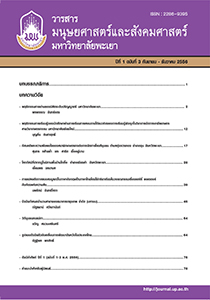การแปลอดีตกาลแบบสมบูรณ์ในภาษาอังกฤษเป็นภาษาไทยโดยใช้กริยาเรียงในวรรณกรรมเรื่องแฮร์รี่ พอตเตอร์กับห้องแห่งความลับ
Keywords:
การแปล, อดีตกาลแบบสมบูรณ์, กริยาเรียง, Translation, Past Perfect Tense, Serial VerbAbstract
งานวิจัยนี้มีวัตถุประสงค์เพื่อวิเคราะห์ ศึกษาและจำแนกหมวดหมู่รูปภาษาที่มีโครงสร้างการใช้กริยาเรียงเป็นกลวิธีการแปลโครงสร้างอดีตกาลแบบสมบูรณ์จากภาษาอังกฤษเป็นภาษาไทยระดับอนุพากย์โดยเน้นศึกษาจำเพาะกริยาเรียงที่บ่งชี้ความหมายของอดีตกาลแบบสมบูรณ์ในวรรณกรรมแปลเรื่อง แฮร์รี่ พอตเตอร์กับห้องแห่งความลับ ตามแนวทฤษฎีไวยากรณ์หน้าที่นิยมเชิงแบบลักษณ์ภาษา
ผลการวิจัยพบว่ามีโครงสร้างการแปลโดยใช้รูปแบบกริยาเรียงที่บ่งอดีตกาลแบบสมบูรณ์ 6 โครงสร้าง ได้แก่กริยาวลี+อยู่, กริยาวลี+กรรม+อยู่..., กริยาวลี+เสร็จ, กริยาวลี+นามเสร็จแล้ว, กริยาวลี+มา และ กริยาวลี+มาแล้ว
The Translation of English Past Perfect Tense with Thai Serial Verbs in Harry Potter and the Chamber of Secrets
Nopparat Chansopha
Department of Western Languages, Faculty of Humanities, Naresuan University Philanulok, Philanulok
This article aims at analyzing, studying and categorizing of Thai language construction translated from English to Thai by using serial verb construction in Harry Potter and the Chamber of Secrets. Thai serial verbs indicating Past Perfect Tense construction are mainly focused in this studying, and Functional Typological Grammar is the main theory of the study.
The results are significantly found that there are 6 construction of Thai translation using serial verb construction to indicate the interpretation of Past Perfect Tense: verb + /jʊ/, verb + object + /jʊ/, verb + /sed/, verb+ object+ /sedlæw/, verb + /mɑː/ and verb + /mɑːlæw/.
Downloads
How to Cite
Issue
Section
License
ผู้นิพนธ์ต้องรับผิดชอบข้อความในบทนิพนธ์ของตน มหาวิทยาลัยพะเยาไม่จำเป็นต้องเห็นด้วยกับบทความที่ตีพิมพ์เสมอไป ผู้สนใจสามารถคัดลอก และนำไปใช้ได้ แต่จะต้องขออนุมัติเจ้าของ และได้รับการอนุมัติเป็นลายลักษณ์อักษรก่อน พร้อมกับมีการอ้างอิงและกล่าวคำขอบคุณให้ถูกต้องด้วย
The authors are themselves responsible for their contents. Signed articles may not always reflect the opinion of University of Phayao. The articles can be reproduced and reprinted, provided that permission is given by the authors and acknowledgement must be given.








